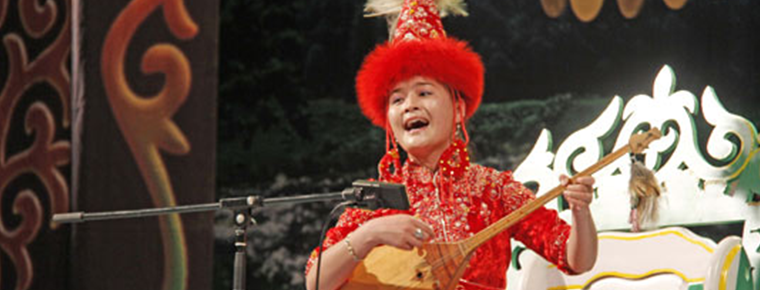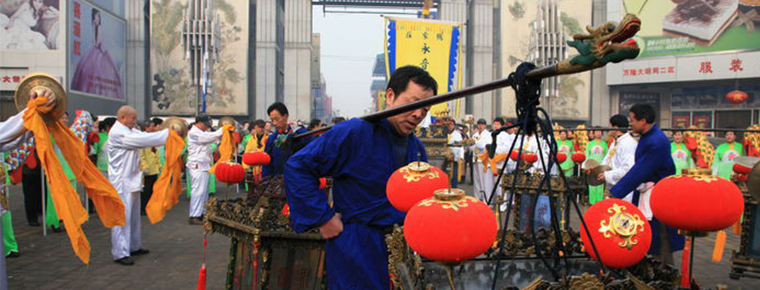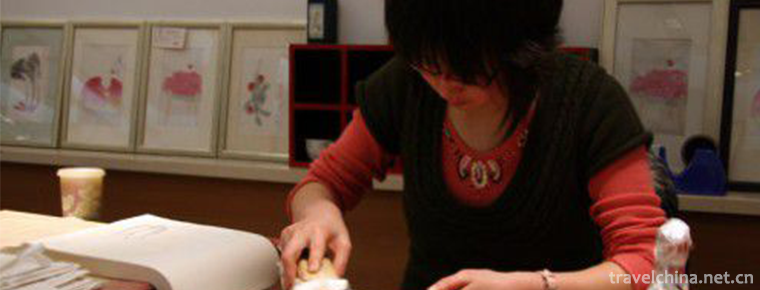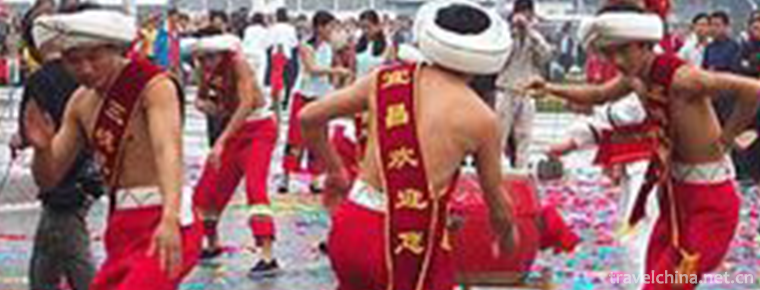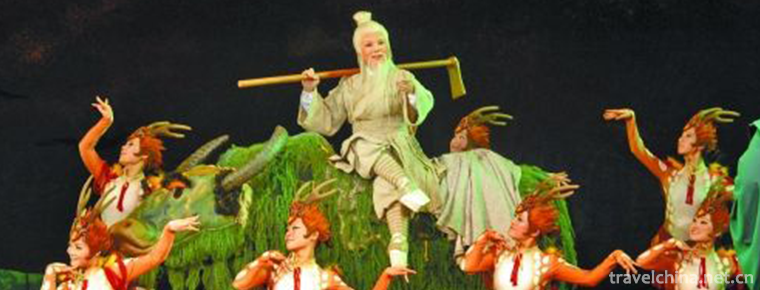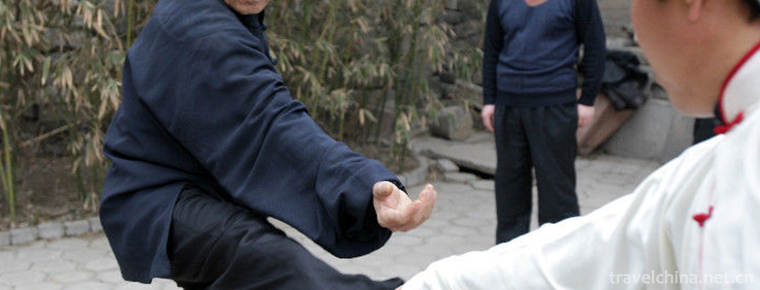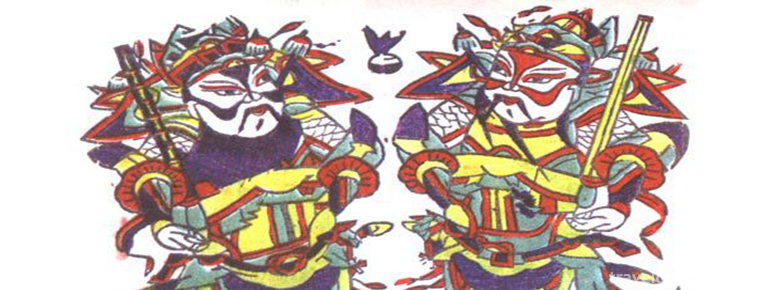Changdian Temple
Changdian Temple
Changdian Temple Fair is a traditional folk custom and folk religious belief activity in Beijing. Among the many temple fairs in the old capital city, only the temple fairs in Changdian, not in the name of temples, are held from the first to the fifth day of the first month of the first lunar month every year. They are the largest, most Beijing-flavored, most famous and well-known.
The Miao Dian temple fair and Nanjing Confucius temple, Shanghai Town God's Temple and Chengdu Qingyang Temple are also known as the four largest temple fairs in China.
After liberation, the temple fair in Changdian was still held until the early 1960s. It was still very popular, but unfortunately it died and died for 37 years. Perhaps to cater to the nostalgia of the people in Beijing, the Beijing Municipal Government restored the Changdian Temple Fair in 2001.
On May 20, 2006, the Changdian Temple Fair was approved by the State Council to be included in the first batch of national intangible cultural heritage lists.
Basic situation
The Changdian Temple Fair in Xuanwu District of Beijing began in Jiajing in Ming Dynasty, flourished in Kangxi in Qing Dynasty and flourished in Qianlong. In the seventh year of the Republic of China (1918), after the rectification of the municipal authorities, it was officially decided to hold a temple fair in Changdian and Haiwangcun Park from the first to the fifteenth day of January every year, which became the only official Spring Festival temple fair in the old capital. Around 1945, the Changdian Temple Fair was close to the "broken lamp temple". After liberation in 1949, temple fairs were held every year from the first to the fifteenth day of the first lunar month from Heping Men to Hufang Bridge. In 1960, it was interrupted by natural disasters. In 1963, the city government reopened the Changdian Temple Fair, causing a sensation throughout the city. Later, due to road construction and the "Cultural Revolution", the Changdian Temple Fair was suspended.
The Changdian Temple Fair lasted for more than 400 years. It has been through sacrifice to the temple market, and turned to the evolving process of the Spring Festival shopping in Changdian, where the book market has gradually become a literary merchant. It is known as "combining elegance with vulgarity, merchandise with entertainment". Historically, the Changdian Temple Fair started at the Peace Gate in the north, arrived at Liangjiayuan in the south, went to Liuxiang in the north and South in the west, and Yanshou Temple Street in the east. It took Xinhua Street, Haiwang Village, Fire Temple and Lv Zu Temple as its core area, and mainly took the "East Gate of the Factory" as the East Street of Liulichang. As the Changdian Temple Fair is nearest to the city centre, it is a place where men and women from all walks of life compete for patronage during the Old Lunar New Year. In Guangxu's Changdian Ji, it was said that "in peacetime, there are few people; in the first month, there are many ladies and gentlemen in the city, like clouds in full swing, hand-in-hand in the car, and they are on the way."
Temple fairs, or temple markets, were originally called "community sacrifices" and originated from traditional folk religious activities. In the old days, there were Buddhist things in temples. When there were Buddhist things, pilgrims flocked together. They attracted businessmen to do business. Thus, temple fairs were formed. Among the many temple fairs in the old capital, only the temple fairs in Changdian, not named as temples, are held only once a year during the Spring Festival, but they are the largest, most Beijing-flavored, most famous and well-known.
After liberation, the temple fair in Changdian was still held until the early 1960s. It was still very popular, but unfortunately it died and died for 37 years. Perhaps to cater to the nostalgia of the people in Beijing, the Beijing Municipal Government restored the Changdian Temple Fair in 2001. Every Spring Festival, the address of Changdian Temple Fair still takes Liulichang as the central axis, starting at the Heping Gate intersection in the north and ending at the Hufang Bridge intersection in the south, with a total length of 1050 meters.
Changdian Temple Fair is one of the eight major temple fairs in Beijing history, and it is also the largest and most influential of the eight temple fairs. The Miao Dian temple fair and Nanjing Confucius temple, Shanghai Town God's Temple and Chengdu Qingyang Temple are also known as the four largest temple fairs in China. Even in the most depressed days of the Changdian Temple Fair, one-fifth of the resident population of the capital could be visited in a single day. Almost none of the old Beijing had ever visited the Changdian Temple Fair.
The Changdian Temple Fair relies on three small temples, Fire Temple, Lv Zu Temple and Land Temple, located in Nanxinhua Street, Xuanwu District, Beijing. These three temples have been used for other purposes or have been demolished. In its heyday, the Temple Fair of Changdian started at the Peace Gate in the north, arrived at Liangjiayuan in the south, went to Liuxiang in the north and South in the west, and Yanshou Temple Street in the east. The core of the whole Temple Fair was Haiwang Shao Park in Xinhua Street (today's Chinese bookstore). Because of the dense glaze factory near the bookstore, the cultural atmosphere of the Changdian Temple Fair is very strong, and many vendors are dealing in books, antiques, calligraphy and painting stationery, which is also the unique feature of the Changdian Temple Fair.
Historical inheritance
The Changdian Temple Fair in Xuanwu District of Beijing has a history of more than 400 years. It began in Jiajing in Ming Dynasty, flourished in Kangxi in Qing Dynasty and flourished in Qianlong.
In the past, during the Spring Festival, there were eight temple fairs, such as Changdian, Baiyun Guan and Dazhong Temple. Among them, Changdian Temple Fair is the most famous one. Its scale and duration (from the first to the fifteenth day of the first lunar month) are incomparable with other temple fairs. In 1918, the Beiping Municipal Government officially recognized Changdian as the only official Spring Festival temple fair in Kyoto.
Although Changdian is a place name, it is not a Hutong or street name. Changdian is a small alley east of Nanxinhua Street Road in Xuanwu District. Historically, the Changdian Temple Fair started at the Peace Gate in the north, arrived at Liangjiayuan in the south, went to Liuxiang in the north and South in the west, and to Yanshou Temple Street in the east. Xinhua Street, Haiwang Village, Fire Temple and Lv Zu Temple are the core areas, and the "East Gate of the Factory" is the main East Street of Liulichang. In Yuan Dynasty, the government set up a kiln here to make glazed tiles, so it is called Changdian Liulichang. Most temple fairs are named after temples. There are three temples in Changdian Temple Fair, namely Fire Temple, Lv Zu Temple and Land Temple. These three temples were built in the Ming Dynasty. The Fire Temple is now Xuanwu District Cultural Museum. Lv Zu Temple is located in No. 7 of Changdian. The Land Temple has been demolished and the original place is now Xuanwu District Experimental Kindergarten. Because these three temples are very close, and are in the first month of the lunar calendar, Buddhism is thriving, people and vendors are linked together, so they are called Changdian Temple Fair.
The Changdian Temple Fair is a place where men and women from all walks of life compete for patronage in the Old Calendar New Year. According to Qianlong's "Jisheng at the age of Emperor Beijing" records: "Every January from New Year's Day to the 16th, department stores gather... "Thousands of contacts, books, treasure play fill the streets," Guangxu years, "Changdian Ji" said: "usually empty, rarely traveled; to the first month, the city ladies, like clouds, car-carrying hand-in-hand, in the road. "In 1918, the Changdian Temple Fair was officially recognized by the Beiyang Government as the only official Spring Festival temple fair in the old capital. In 1945, there were still more than 200,000 tourists, accounting for one fifth of the capital's population at that time; in 1960, natural disasters interrupted for a while; in 1963, the city government reopened the Changdian Temple Fair, causing a sensation throughout the city, with numerous tents and tents, and stall vendors back to back.
The Temple Fair held in Changdian can flourish and has a direct relationship with Liulichang. Liulichang is the old Beijing culture
One of the most authentic and rich atmosphere is the bookshop, the antique shop and the newspaper room, all of which are the top choices of the time in the capital. The high-ranking officials who have been living in Beijing Normal University for a long time and have taken the examinations in Beijing have no ignorance of Liulichang. If they do not come to Liulichang, they can find out many good texts and cultural works of ancient books as long as they are patient and carefully visited.
In the old days, the temple fairs in Changdian were not small in scope. Shops and vendors gathered together calligraphy and painting treasures, pamphlet fans, Beijing-style snacks, dried and fresh specialties, diabolo gyroscopes, windmill kites, needle thread brains and grocery stores to meet people's needs of eating, drinking and shopping. Naturally elegant and vulgar are appreciated together, and less long and salty is appropriate.
Cultural connotations
Changdian, the oldest Spring Festival temple fair in Beijing, is a landmark temple fair in Beijing, which has been separated from the people of Beijing for nearly 40 years.
The Temple Fair has a long history in Beijing, which can be said to be one of the rich cultural connotations of the ancient capital of the Six Dynasties. In the past, during the Spring Festival in old Beijing, there were several major temple fairs such as Changdian, Baiyun Guan and Dazhong Temple, among which Changdian Temple Fair was the most famous. Changdian Temple Fair began in Jiajing of Ming Dynasty, flourished in Kangxi of Qing Dynasty, flourished in Qianlong, declined in the Republic, recovered after the founding of New China, and disappeared in the early period of "Cultural Revolution". It lasted more than 400 years, and experienced the evolution process from sacrifice to lamp market, to book market gradually becoming a trade market. It is famous for its combination of elegance and vulgarity, and the integration of business and entertainment. Like Nanjing's Confucius temple, Shanghai Town God's Temple and Chengdu Qingyang Temple, it has become a landmark temple fair with long history, profound connotation, extensive foundation, far-reaching influence and distinctive features.
Peking people love to visit temple fairs, also known as temple fairs, mostly held in or around temples, which is a unique form of market transactions in China. Visiting Changdian during the Spring Festival is the best place to understand the folk customs and customs of northern China represented by Beijing.
The Changdian Temple Fair, with its long history, grand scale and open form, especially its distinctive Beijing-flavor cultural characteristics, has become a window and platform for displaying Beijing-flavor folk culture and Xuannan culture. It is a grand stage for gathering the fine works of traditional folk culture and art from all over the country. It has profound cultural connotation and wide social significance, and is deeply influenced by the people of Beijing. It has attracted many national folk traditional projects and the active participation of excellent traditional folk artists, resulting in increasing social and economic benefits.
In 2001, after 37 years'absence from the capital, the Changdian Temple Fair appeared before the people of the capital with its brand-new features, profound cultural connotation and elegant cultural taste. It became a landmark temple fair in Beijing in one fell swoop, which made this long-standing cultural activity continue to be inherited.
Beijing business card
Folklore scholars cordially call Changdian Temple Fair Beijing's cultural card, because it is one of the eight major temple fairs in Beijing's history, and one of the eight largest and most influential temple fairs. The Changdian Temple Fair started in Jiajing period of Ming Dynasty and has lasted for more than 400 years. In the past, it was the four largest temple fair in China with Confucius temple in Nanjing, Town God's Temple in Shanghai and Qingyang Temple in Chengdu. Changdian Temple Fair has always been outstanding in books, antiques, calligraphy and painting stationery, since ancient times it has been known as "Wenshi". At the same time, special snacks, traditional crafts, daily department stores and children's toys are also well-known. People who visit temple fairs have three religions and nine streams, and workers, farmers and businessmen are everywhere. Men and women, old and young, can enjoy themselves here and have their own gains. Its unique entertainment atmosphere is also attractive, stilts, drums, car clubs, five tiger sticks... All kinds of Flower Fairs compete to perform, and the old artists of Beijing overpass perform for you. Taste snacks represented by big sugar gourd can not be missed .
Featured activities
The Temple Fair has changed the form of closed parks and implemented an open pedestrian Tourist Commercial Street model. The contents include the traditional Flower Fairs in old Beijing, the old photo exhibitions in old Beijing folk customs, the traditional commercial "cover" exhibition, the traditional opera performances such as the old overpass, Beijing Opera, and the special book market, etc. The forms are diverse and splendid.
Sweet and attractive sugar gourds, kites and windmills with different styles and other products with Changdian's traditional characteristics are reproduced. Skillful craftsmen from the north and South also display their crafts on one street, one street and two streets.
Of course, many old brands in Liulichang Cultural Street are unwilling to be lonely. Rong Baozhai took the lead, and the watermarking of wooden editions has made great contributions for a hundred years. The cultural reproduction of Ji Guge, Li Fushou's craftsmanship of making pens, and the renovation of old books in Chinese bookstores have made tourists have a great eye-opener. Traditional wedding ceremonies in old Beijing, such as sedan chair, fire-jumping basin and head-lifting, have also appeared at the temple fair.
Toys that can't be bought in stores, such as single and double diabolos, windmills that rattle against the wind, gyroscopes that drip around on the ground, and five-foot-long sugar gourds, all kinds of zodiac objects, can be found there. Its purpose is to show the people of Beijing with fresh and surprise, highlight the tradition, show new ideas, and make full Beijing flavor, so that the new century Changdian Spring Festival Temple will be more lingering, lively and unforgettable .
cultural heritage
The State attaches great importance to the protection of intangible cultural heritage. On May 20, 2006, the folklore was approved by the State Council and listed in the first batch of national intangible cultural heritage lists.
Location scope
Beiqi Xuanwu District South Xinhua Street and Pingmen intersection, south through Hufang Bridge intersection to Hufang Road Cultural Square.
In 2010, a small part of the Changdian Temple Fair was still in place, and most of them moved to Taoran Pavilion. The opening hours are from 9:00 to 17:00 every day from the first day to the fifth day of junior middle school. The admission ticket for Tao Ranting is 2 yuan .
Traffic condition
Bus: 6, 14, 15, 23, 25, 53, 66, 102, 105, Bailibo 102, 603.
Road 59, get off at Taoranting Station.
Metro: Metro Line 2. Get off at Exit C of Heping Men Station. (Liulichang Meeting Hall)
Metro Line 4, Taoranting Station can get off. (Taoranting Park Meeting Hall)

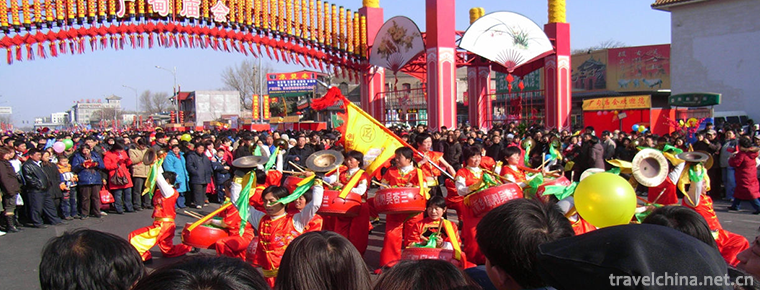
-
Wuyuan County
Wuyuan County, now under the jurisdiction of Shangrao City, Jiangxi Province, is one of the six counties in ancient Huizhou. .
Views: 182 Time 2018-11-11 -
Kazakh Tiermai
Tiermai, which means "short poem" in Kazakh language, usually implies philosophy in the poem in a narrative way to give people inspiration. This kind of poem is widely spread among Kazakh he.
Views: 180 Time 2019-05-02 -
Jin men drum
Jinmen Fagu is a local traditional music and dance art in Tianjin, which appears in the form of performances of the Lao Hui or the Sacred Congregation. In June 2008,.
Views: 137 Time 2019-05-07 -
Wood Watermarking Techniques
Wooden watermarking is mainly made by such basic technological procedures as hook (sub-plate), engraving (plate-making), printing (printing) and special techniques as engraving, picking and dusting..
Views: 155 Time 2019-06-06 -
Pudong Publicity Book
Nanhui Xuanjuan is an ancient traditional art of rap and singing. Xuanjuan originated from "vulgar speaking" in Tang Dynasty and "Tanjing" in Song Dynasty. It is a term used by Bud.
Views: 111 Time 2019-06-09 -
Sayerhao of Tujia Nationality
"Sayeer Hao" of Tujia nationality in Changyang, Hubei Province is a kind of sacrificial song and dance of Tujia nationality in the middle reaches of Qingjiang River valley. "Sayer Haw&q.
Views: 367 Time 2019-06-23 -
Extra tune
In addition to the form of opera, Yue Diao has two branches, namely, opera and puppet. In 1942, there was a severe drought in Henan Province. During this period, many cross-tone artists (such as Zhang.
Views: 263 Time 2019-07-16 -
Elbow pounding
This is a rather mysterious school, which originated from a famous family in Linqing, and is closely related to the chivalrous spirit inherent in the Chinese people; it is a fierce school, but it has .
Views: 417 Time 2019-08-10 -
Zhuxian Town Wood Print New Year Picture
Zhuxianzhen Wood Engraving New Year Picture is one of the ancient Chinese traditional crafts. As the originator of Chinese woodcut New Year pictures, is mainly distributed in Kaifeng, Zhuxian Town and.
Views: 133 Time 2019-08-10 -
North Sichuan Medical College
North Sichuan Medical College is located in Nanchong City, a famous historical and cultural city in Sichuan Province and the birthplace of Three Kingdoms Culture. The school's predecessor was the Nort.
Views: 281 Time 2019-08-31 -
Xianshi ancient town scenic spot in Zigong City
Xianshi ancient town scenic spot in Zigong City stands on the Bank of Fuxi River 11 kilometers southeast of Zigong City, the "Millennium salt capital", which is in contrast with Zigong, a famous historical and cultural city..
Views: 176 Time 2020-10-15 -
Leshan peoples life
By the end of 2018, the per capita disposable income of rural residents in Leshan City was 15173 yuan, an increase of 8.9%, and the per capita living consumption expenditure was 12309 yuan, an increase of 9.5%. The per capita disposable income of urban residents .
Views: 294 Time 2020-12-17

